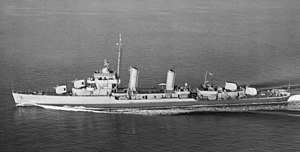USS Welles (DD-628)

| |
| History | |
|---|---|
| Name | Welles |
| Namesake | Gideon Welles |
| Builder | Seattle-Tacoma Shipbuilding Corporation |
| Laid down | 27 September 1941 |
| Launched | 7 September 1942 |
| Commissioned | 16 August 1943 |
| Decommissioned | 4 February 1946 |
| Stricken | 10 February 1968 |
| Fate | Sold for scrapping, 18 July 1969 |
| General characteristics | |
| Class and type | Gleaves-class destroyer |
| Displacement | 1,630 tons |
| Length | 348 ft 3 in (106.15 m) |
| Beam | 36 ft 1 in (11.00 m) |
| Draft | 11 ft 10 in (3.61 m) |
| Propulsion |
|
| Speed | 37.4 knots (69 km/h) |
| Range | 6,500 nmi (12,000 km; 7,500 mi) at 12 kn (22 km/h; 14 mph) |
| Complement | 16 officers, 260 enlisted |
| Armament |
|
USS Welles (DD-628), a Gleaves-class destroyer, was the second ship of the United States Navy to be named for Gideon Welles.
Welles was
Service history
Following
Southwest Pacific Area
Welles and her traveling companions arrived at
In March, she returned south to the area around
Leaving
She returned to
Western Pacific
She moved into
For the remainder of her participation in the war Welles cruised with either the fast carriers or with their logistics unit as the flattops launched air strikes on Japan's inner defenses and supported from a distance the invasions at Luzon, Iwo Jima, and Okinawa.
In June 1945, she retired to Leyte for rest and upkeep. On the 21st of that month, she received orders to return to the United States for a major overhaul. Steaming via
On 29 September, she got underway for the east coast. After a stop at
Welles earned eight
References
This article incorporates text from the public domain Dictionary of American Naval Fighting Ships. The entry can be found here.
